C3.1 Integration of body systems SL
1/100
There's no tags or description
Looks like no tags are added yet.
Name | Mastery | Learn | Test | Matching | Spaced |
|---|
No study sessions yet.
101 Terms
System integration
When components communicate + coordinaate
How diff parts of an organism work tog to perform complex functions
Happens on multiple levels of organisation
How important is system integration in living systems?
A necessary process
What is coordination needed for?
Component parts of a system to collectively perform an overall function
Hierarchy of subsystems integrated in a multicellular living organism (levels of organisation)
Cells
Tissues
Organs
Body (organ) systems
How does a cheetah become an effective predator?
By integration of its body systems
Tissue
Group of 2 or more diff cell types w specialised structures + functions, working + communicating tog
Organ
Group of 2 or more types of tissues working tog to perform a specific function
Organ system
Group of organs working tog to perform a life function
Organism
A living thing made up of multiple integrated + interdependent systems at various levels of organisation
Emergent properties
Only in multicellular organisms
Characteristics that arise when smaller components combine to form larger systems
“whole is greater than the sum of its parts”
What is responsible for emergent properties?
Integration
Integration of organs in animals requires coordination, which requires?
Communication via:
a) Hormonal signalling
b) Nervous signalling
Transport of materials + energy
Hormones
Chemical messengers produced by endocrine glands
Travel via BS to act on target cells (with the proper receptor)
Nervous signalling
Uses electrical impulses
EI transmitted by neurons to specific location
Effects muscles / glands only
Nervous vs endocrine system in sending messages
Nervous:
Uses EI
EI travel via neurons
Rapid
V short
Affects only specific muscles / glands
Endocrine:
Uses hormones
Hormones travel via BS
Slower
Lasts a longer time (until hormone is broken down)
Travels to whole body
Examples of systems that transport materials + energy
Circulatory system- blood transports oxygenated blood, urea, glucose, hormones
Digestive system- food transported from oesophagus to stomach
Brain
Central information integration organ
Stores + processes info combined from several inputs (sensory receptors)
Role in learning + memory
Sends signals to effector organs via motor neurons if response is needed
Spinal cord
Integrating centre for unconscious processes
Aka reflexes
2 parts of the nervous system
Central NS
Peripheral NS (nerves)
Parts of the CNS
Brain
Spinal cord
2 main tissues in the spinal cord
White matter
Grey matter

Functions of white matter (transmission)
Transmit signals from:
i) Sensory receptors to brain
ii) Brain to other organs
What does grey matter contain?
Cell bodies + synapses
Functions of grey matter (processing)
Processes info
Decision making
Unconcious processes only
Concious processes (expand on this)
Voluntary actions
Involve awareness + decision-making
Controlled by the cerebral hemispheres
Unconscious processes (expand on this)
Occur w/o conscious thought- eg reflexes (rapid, involuntary responses to stimuli)
Spinal cord = integrating centre for UP
Role of sensory neurons
Convey messages from receptor cells to the CNS
Msgs = EI
Sensory receptor → sensory neurons → CNS (brain / spinal cord)
2 groups of receptors + examples
External- touch, heat, light
Internal- stretch, chemo (pH)
Where does info inputted to the spinal cord / cerebral hemispheres come via?
Sensory neurons
Role of motor neurons
Convey messages (output) from CNS (cerebral hemispheres) to the effectors (muscles)
What happens when the output form a cerebral hemisphere reaches a muscle?
Stimulated to contract
Stimulus
Change in the environment (external / internal) that is detected by a receptor
Receptors
Transform the stimuli into nerve impulses that are transmitted to the brain where decision-making occurs
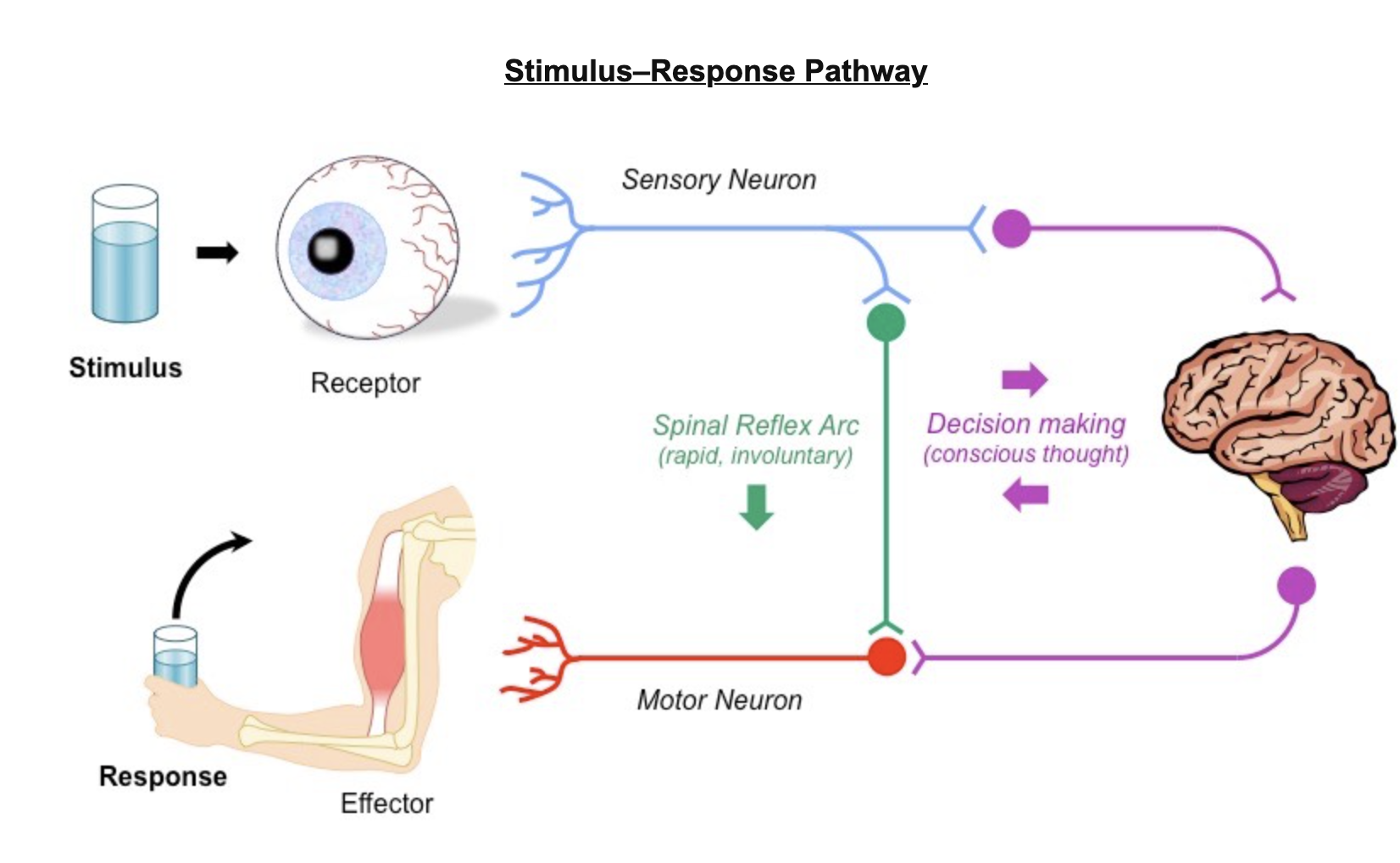
Reflexes
Involuntary + occur w/o conscious thought
Don’t involve the brain (receptor → sensory neuron → spinal cord → motor neuron)
Prof of reflexes
No conscious decision making → faster → protects from danger
Motor neurons have cell bodies in the brain close tog but…
Axons + terminals attach to diff effector organs
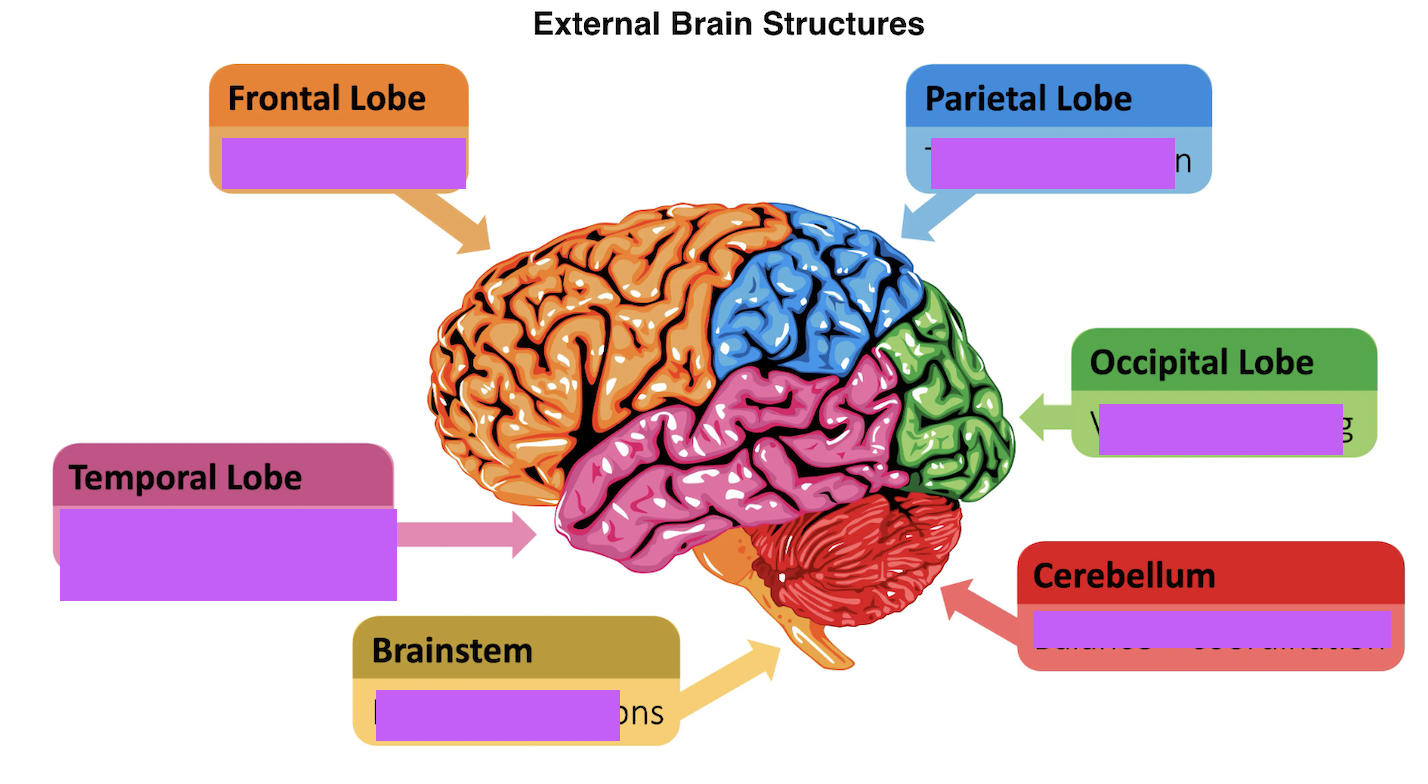
Functions of diff areas of the brain
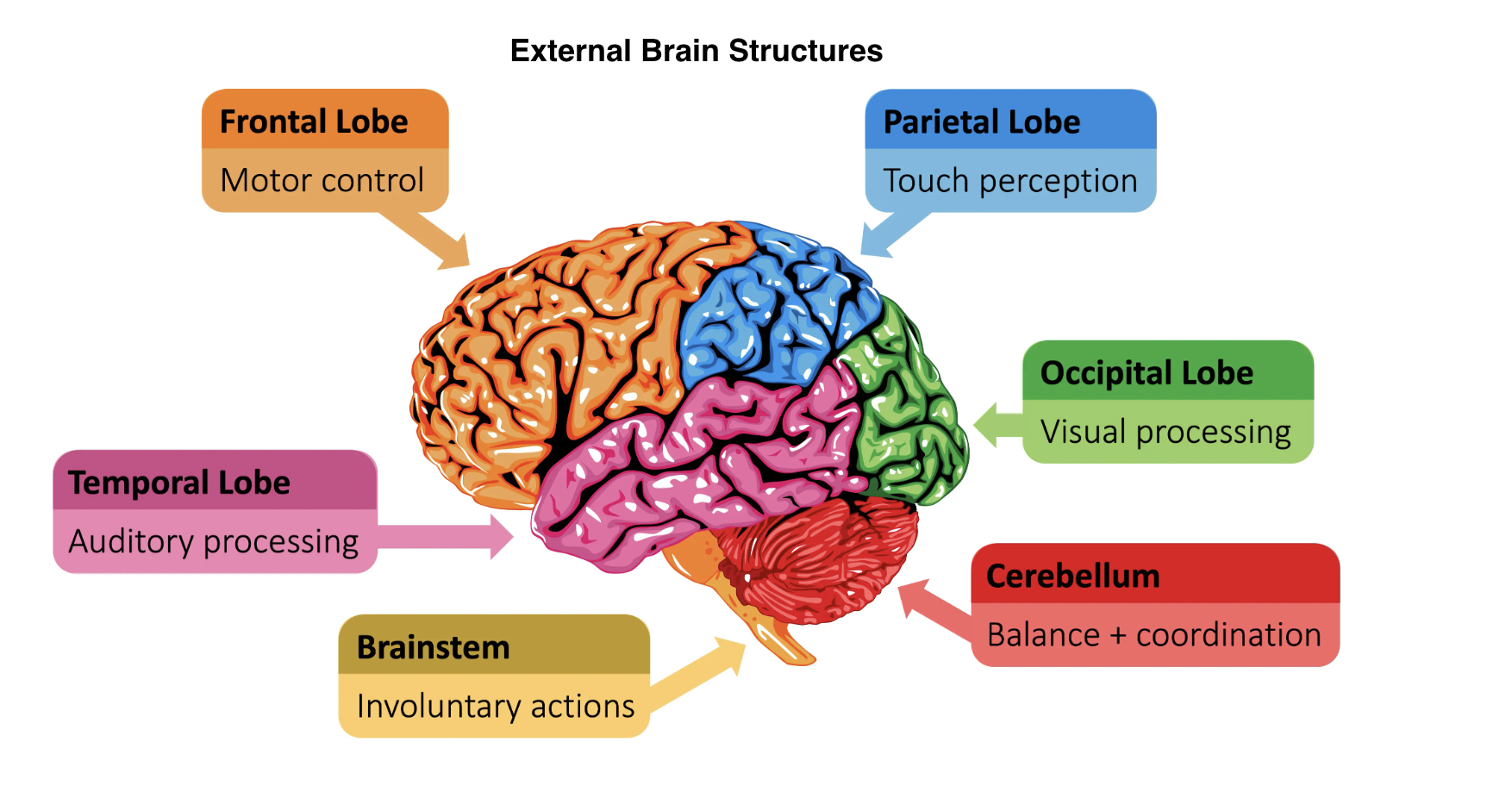
In how many directions can neurons transmit info in?
1
Nerve
Bundle of nerve fibres (sensory AND motor neurons) surrounded by a sheath
Myelin
Increases the speed of nerve impulse transmission
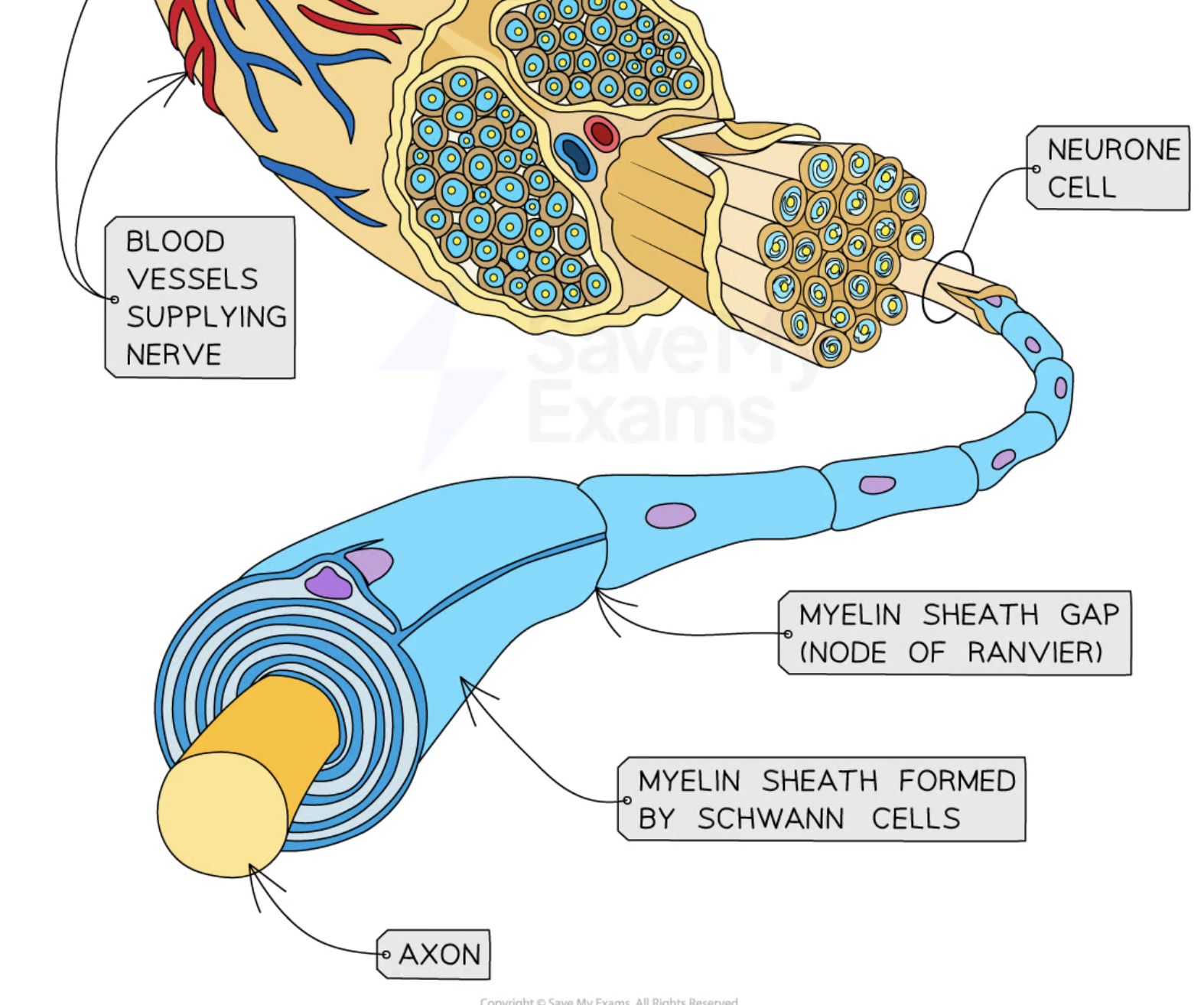
Label a nerve with these features:
Protective sheath
Myelinated nerve fibres
Unmyelinated nerve fibres
Protective sheath
Myelinated
Unmyelinated nerve fibres
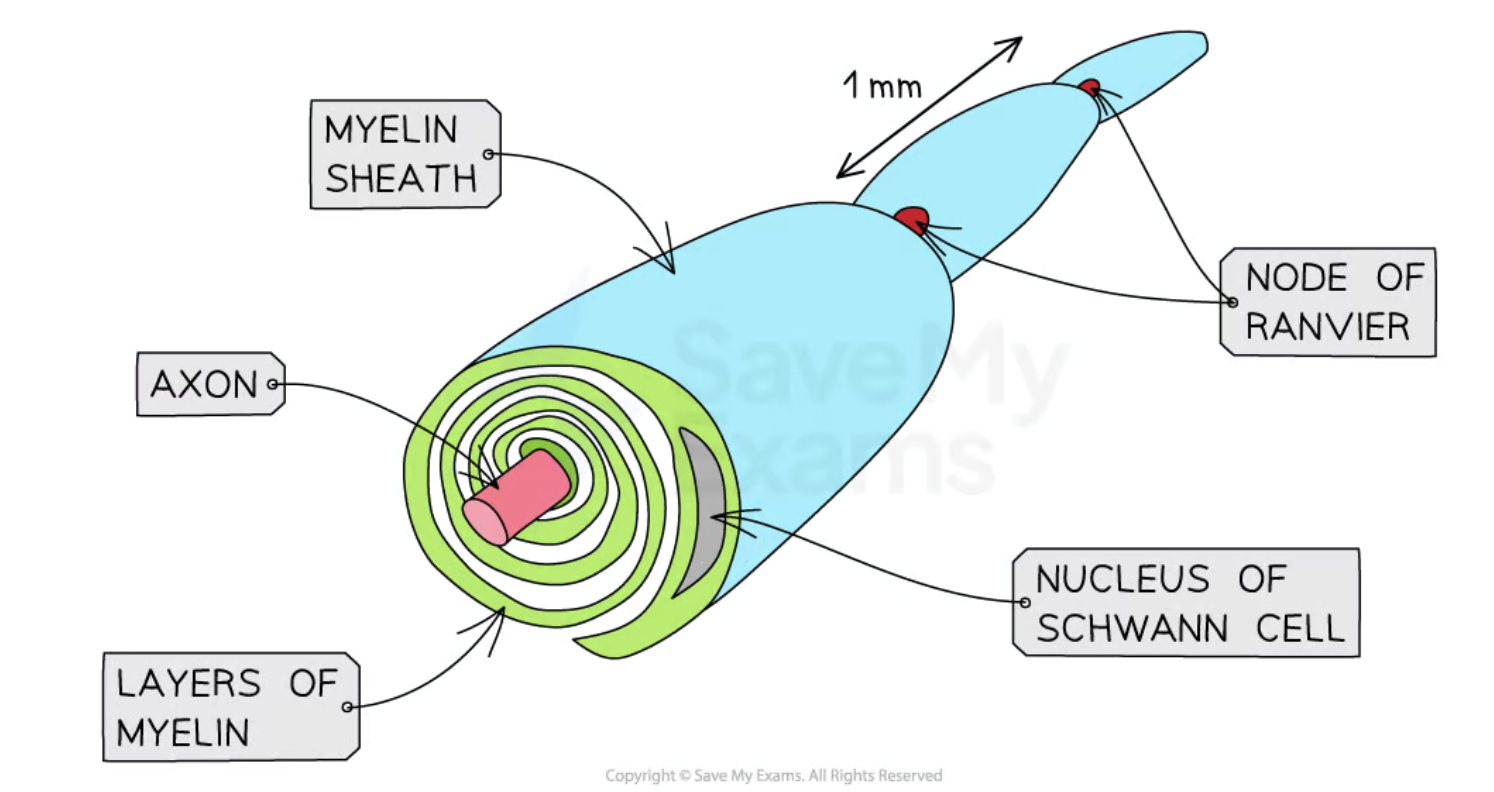
Example of involuntary responses
Pain reflex arcs
Effector in the pain reflex arc
Skeletal muscle
Contracts
Reflex arc
Involuntary + rapid response to a specific stimulus
Receptor (detects stimuli)
Sensory neuron
Interneuron (connects SN to MN)(CNS)
Motor neuron
Effector (muscle / gland)
Pain reflex arc
Pain receptor (in hand)
Sensory neuron (free sensory nerve ending)
1 interneuron in the grey matter of the spinal cord
Motor neuron
Effector- skeletal muscle contracts
Explain the reflex arc
need to complete
Role of cerebellum
Coordinate skeletal muscle contraction
Eg timings of muscle contraction
Balance
Overall control of body movements
Eg things that require muscle memory
Posture
Circadian rhythm
Pattern of sleep / wake cycles that organisms are adapted for
Approx 24 hours
Melatonin
Hormone secreted by the pineal gland
Controls circadian rhythms
Diurnal pattern (repeats every 24 hours) of melatonin
High at night (dark) → sleepy
Low during day (light) → awake
What inhibits melatonin secretion?
Light
How does the diurnal pattern of melatonin help establish a cycle of sleeping + waking?
LIGHT RECEPTOR → CNS → PINEAL GLAND
Day
Light receptor in eye
Senses light → sends info to CNS via sensory neuron
Inhibits melatonin production
Night
Light receptor in eye
Senses less light → sends info to CNS
Promotes melatonin production by pineal gland
Melatonin (hormone) → travels via BS to diff target organs
What does melatonin cause?
Drop in body temp
Drowsiness
Sleep
Another name for adrenaline
Epinephrine
Adrenaline (epinephrine)
Secreted by adrenal glands
Prepares body for vigorous activity (fight or flight
Goal of adrenaline (epinephrine)
Increase glucose + O2 supply to skeletal muscles
Why does adrenaline increase glucose + O2 supply to skeletal muscles
… needed for:
Glucose: energy
Oxygen: ATP energy production via aerobic respiration
How do hormones travel to target organs?
Via bloodstream
6 effects of epinephrine (adrenaline) in the body
Hydrolysis og glycogen (polysaccharide) → glucose
Released into BS
Increased diameter of bronchi + bronchioles
More O2 delivered to blood
Ventilation rate + tidal volume increase
SA node (pacemaker) increases heart rate
More glucose + O2 delivered via blood
Vasodilation → increase blood flow to liver + muscles
Muscle → movement
Liver → glycogen store
Vasoconstriction → decrease blood flow to gut + kidneys
No need to digest food
Why is it important to increase the blood flow to liver during fight or flight?
Liver = glycogen store
Glycogen → glucose
More blood to liver → can pick up more glucose → then send to muscles
What do the effects of adrenaline facilitate?
Intense muscle contraction
What is the endocrine system controlled by?
Hypothalamus + pituitary gland
Hypothalamus sends signals to PG
What is the hypothalamus connected to?
Pituitary gland
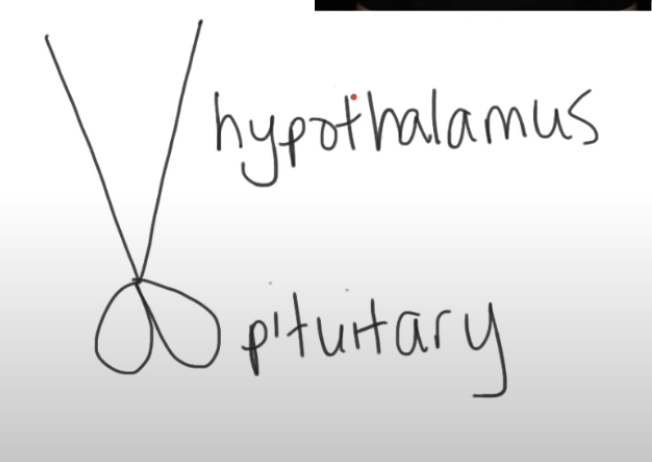
What do the hypothalamus connect?
Connect the nervous + endocrine system
Structure of pituitary gland
2 lobes
Anterior
Posterior
Hypothalamus
Acts as a homeostatic control centre
Regulates hormonal secretion via the pituitary gland
Receives inputs from many sources
Changes input (nervous signalling) → output (hormonal signalling)
Examples of sources where the hypothalamus receives (nervous) inputs from?
Other parts of the brain
Sensors for:
Temp
Blood glucose
Solute concentrations
INPUT (NERVOUS SIGNALLING) → OUTPUT (HORMONES)
Input vs output via the hypothalamus
Input- nervous signalling
Output- hormonal signalling (hormones)
Osmoregulation
Regulates osmolarity / solute concentration of blood
Role of hypothalamus in osmoregulation (how it connects nervous system to endocrine system)
H = hypothalamus
H recieves info from sensory organs (about blood solute conc) (nervous)
Eg solute conc too high →
Prompts PG to release ADH (hormone)
Increases reabsorbption of water in kidneys
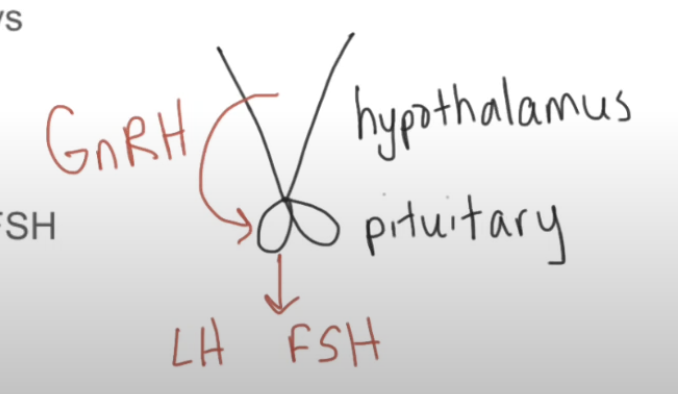
How does the hypothalamus interpret hormonal info, eg during puberty?
Puberty → H releases GnRH
Travels to PG
Causes PG to release LH + FSH
Initiates puberty
Where is the SA (pacemaker) node located?
Right atrium of the heart
SA = sinoatrial node
What does the SA node control?
Heart beat (rate)
What is the SA node connected to in the brain?
SA node connected to medulla oblongata
What nerves connect the SA node to medulla oblongata?
Vagus nerves
Sympathetic nerves
Nerves transmit info from medulla to SA node

Effect of sympathetic vs vagus nerve on SA node
…causes SA node to:
Sympathetic- increase heart rate
Vagus- decrease heart rate
What is the SA node in feedback loops with?
Chemoreceptors
Baroreceptors
Chemoreceptors
Monitor:
Blood pH
O2 conc
CO2 conc
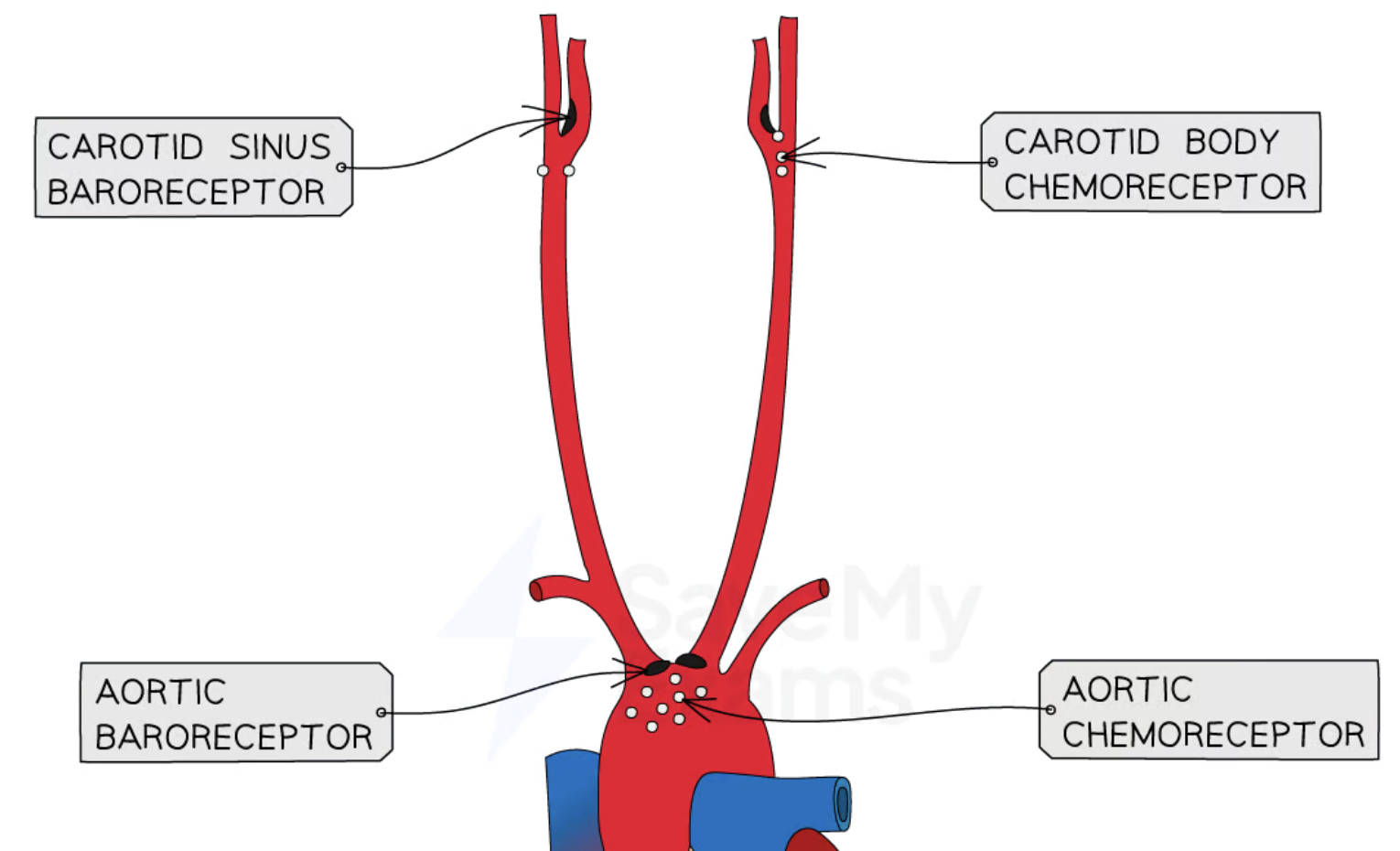
Location of chemoreceptors
Aorta
Carotid arteries
Baroreceptors
Monitor blood pressure
Location of baroreceptors
Aorta
Carotid arteries
General function of these receptors (baro, chemo)
Send input to the medulla in the brainstem
What does the medulla do with the input sent by receptors?
Coordinates the response by sending nerve impulses to the heart to adjust:
Heart rate
Stroke volume
How do chemoreceptors sense CO2 conc?
Chemoreceptors sense low pH = high CO2 conc
What needs to happen when chemoreceptors sense high CO2 conc (low pH) + why?
Increase heart rate → so can pump blood rich in CO2 to the lungs → remove CO2 via ventillation
When there is high CO2 conc (low pH), how does the medulla increase HR?
Medulla oblongata sends msg via sympathetic nerve to SA node to increase heart rate
pH returns to norm → M sends msg via vagus nerve to decrease HR
What happens when baroreceptors sense blood pressure is too low?
Changes occur that tell SA node to increase HR
What can override baro + chemo receptors?
Epinepherine
What causes blood pH changes?
↑ activity = ↑ muscle movement → need ↑ ATP
So ↑ respiration
CO2 = product of respiration → ↑ CO2 (dissolves w water in blood plasma)
So ↓ pH
Muscles controlling ventilation (breathing)
Diaphragm
Intercostal muscles
What happens when blood pH decreases?
Chemoreceptors in brainstem sense pH changes
(medulla) Send nerve signals to diaphgram + intercostal muscles
Causes ventilation rate to increase
Restores normal pH
Is feedback control of ventilation rate following sensory input from chemoreceptors a negative or positive loop?
Negative
Bc when blood pH returns to normal homeostatic levels, breathing rate decreases
What monitors blood pH changes?
Chemoreceptors in the brainstem
What do chemoreceptors in the brainstem control?
Ventilation rate using signals to the diaphragm + intercostal muscles
2 types of nervous system that control digestion
Central nervous system (CNS)
Enteric nervous system (ENS)
Peristalsis
Involuntary wave of muscle contractions that move food thru the digestive tract + stomach
Voluntary parts of digestive system movements
Initiation of swallowing food
Egestion of faeces
What are voluntary movements controlled by?
Eg:
Initiation of swallowing of food
Egestion of faeces
CNS
Involuntary parts of digestive system movements
Peristalsis
Betw initiation + egestion
What are involuntary movements in the digestive system controlled by?
Eg:
Peristalsis
Enteric nervous system (ENS)